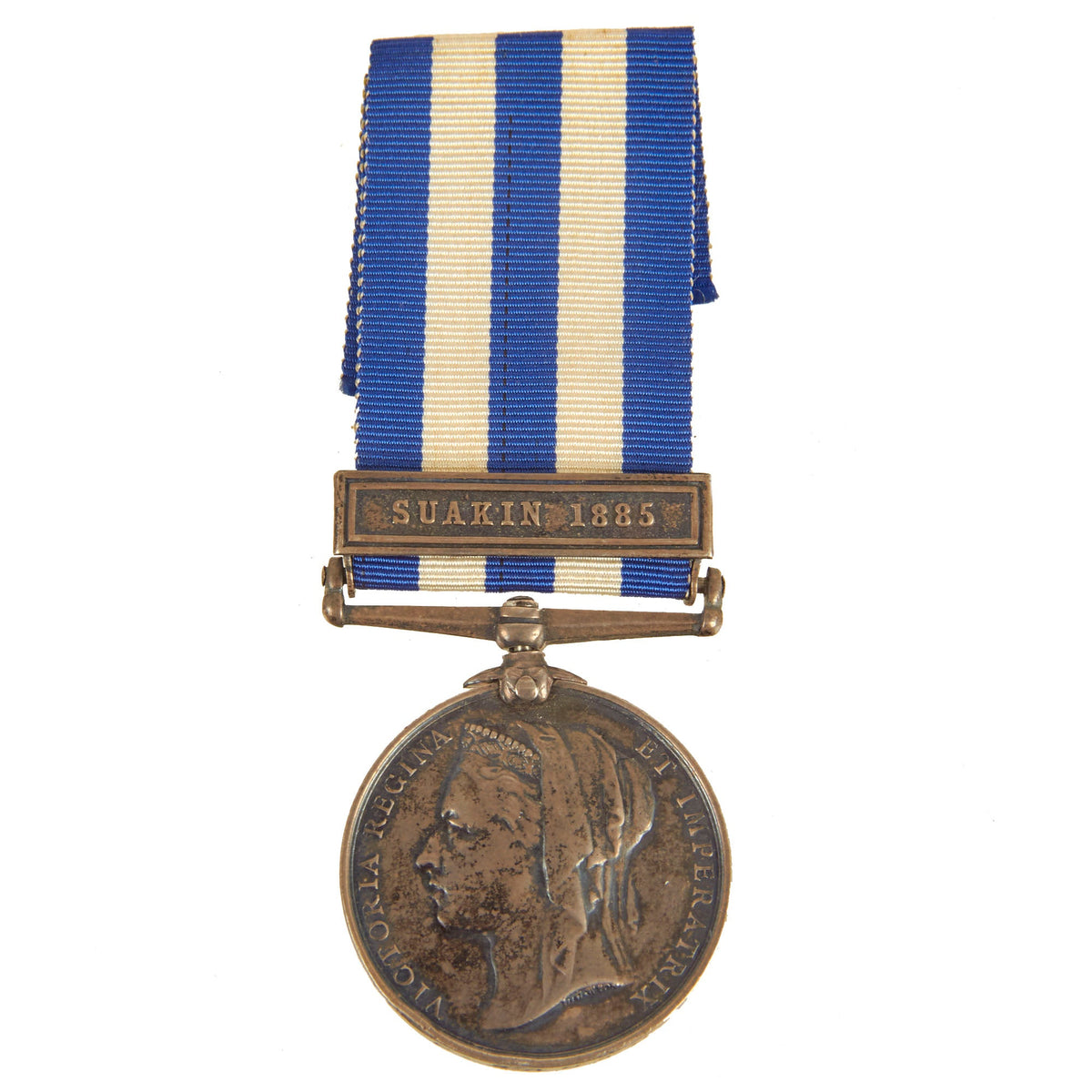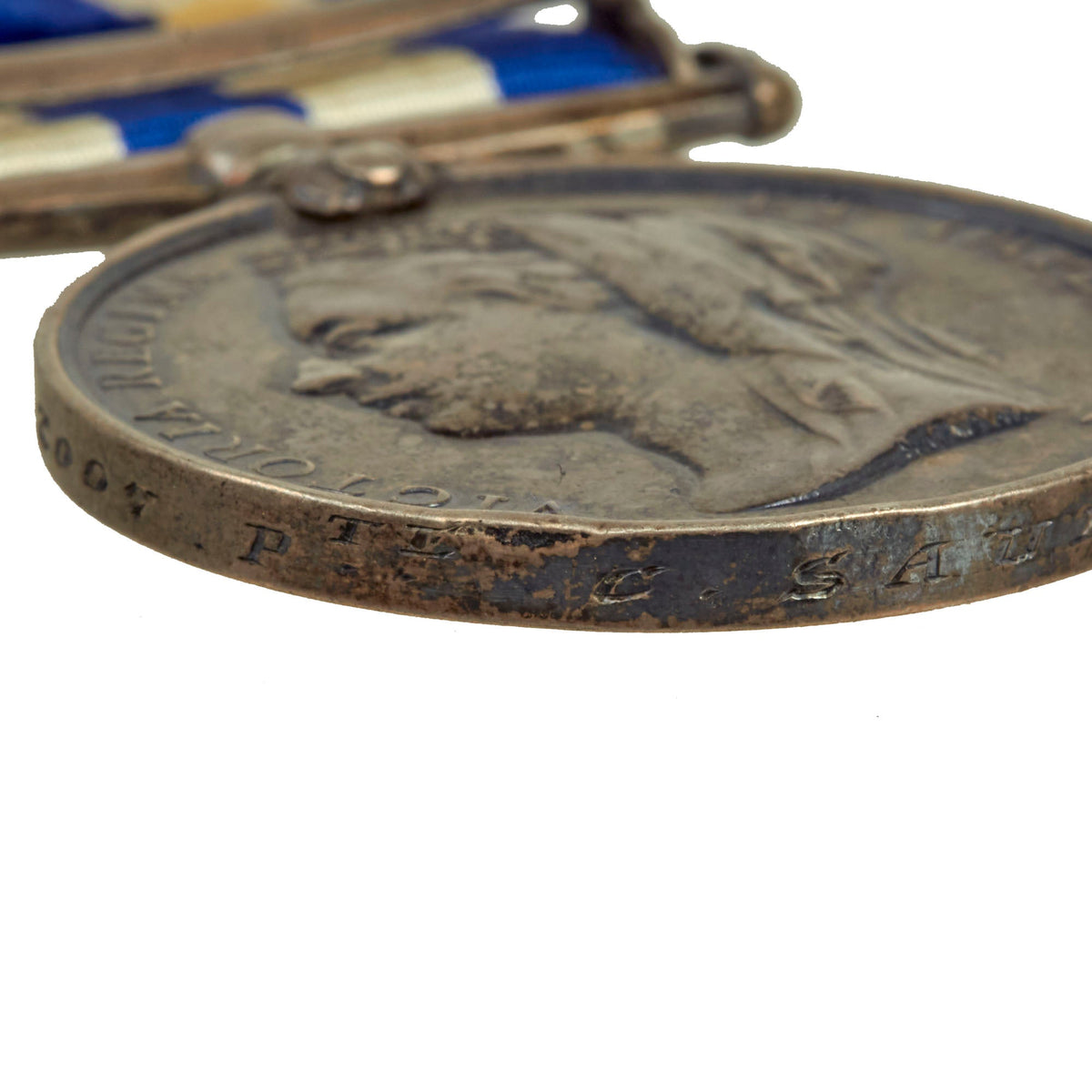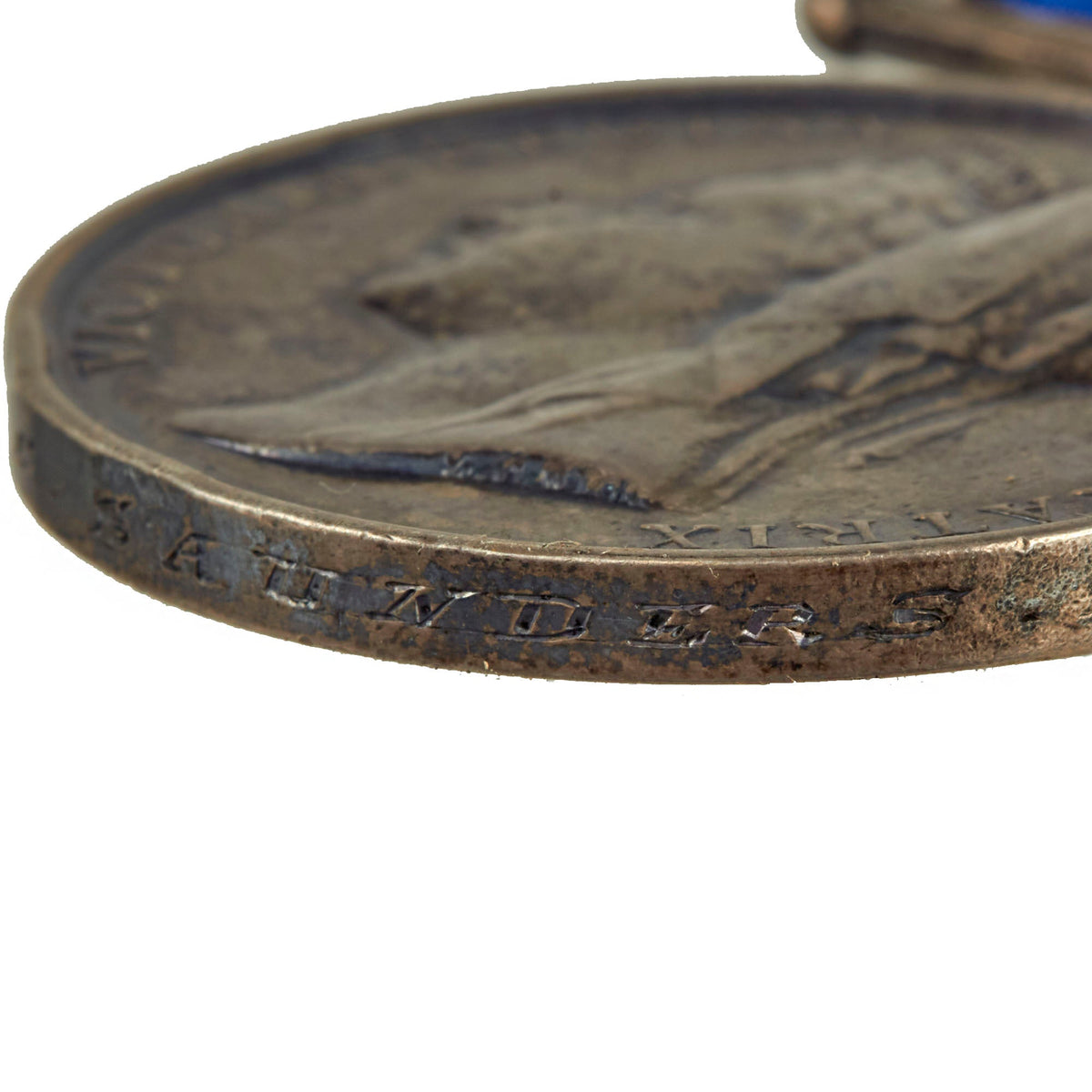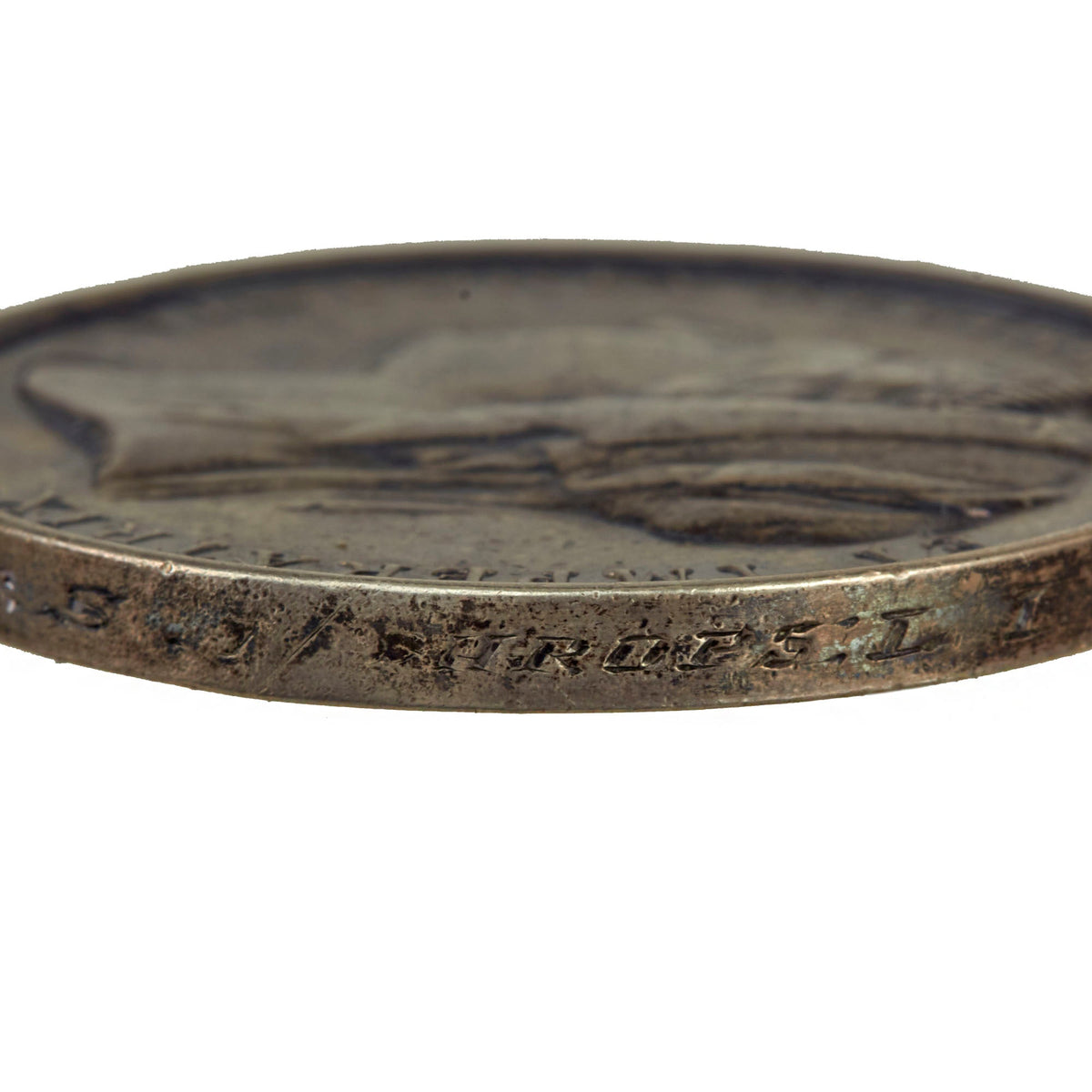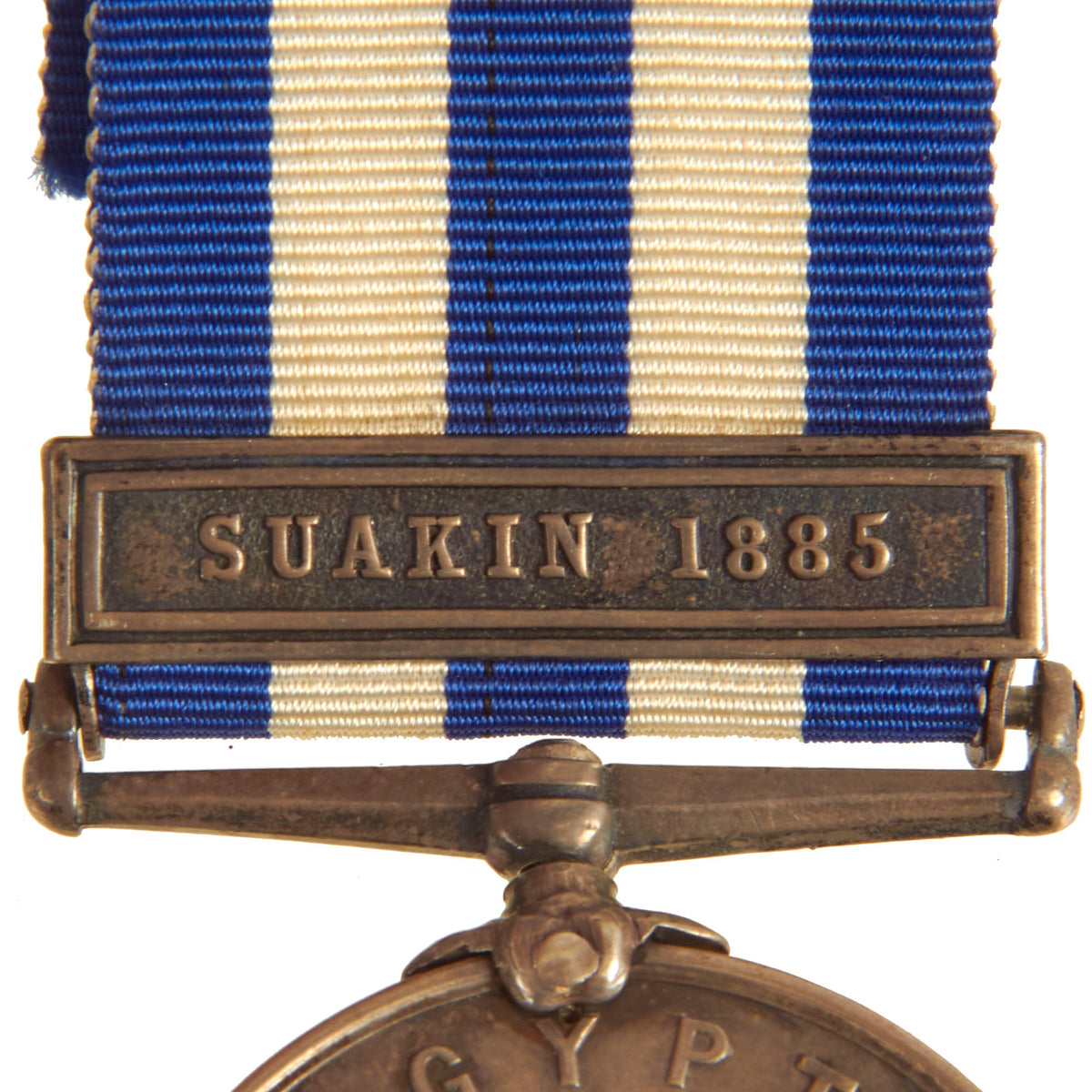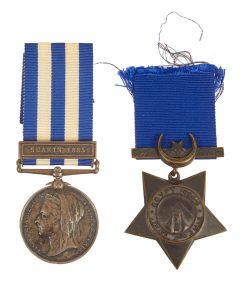Original British Mahdist War Suakin Expedition Rim Engraved Egypt Medal With Suakin 1885 Clasp and Bronze Khedive’s Star – Private Charles Saunders, 1st Battalion Shropshire Light Infantry Original Items
$ 595,00 $ 178,50
Original Items: Only One Grouping Available. The Mahdist War was a war between the Mahdist Sudanese, led by Muhammad Ahmad bin Abdullah, who had proclaimed himself the “Mahdi” of Islam (the “Guided One”), and the forces of the Khedivate of Egypt, initially, and later the forces of Britain. Eighteen years of war resulted in the creation of Anglo-Egyptian Sudan (1899–1956), a de jure condominium of the British Empire and the Kingdom of Egypt in which Britain had de facto control over Sudan. The Sudanese launched several unsuccessful invasions of their neighbors, expanding the scale of the conflict to include not only Britain and Egypt but also the Italian Empire, the Congo Free State and the Ethiopian Empire.
The Medals In This Lot:
– Egypt Medal (1882–1889) With Suakin 1885 Clasp: The Egypt Medal was awarded for the military actions involving the British Army and Royal Navy during the 1882 Anglo-Egyptian War and in the Sudan between 1884 and 1889.
Resentment at increasing British and other European involvement in Egypt since the opening of the Suez Canal in 1869 triggered an Egyptian army mutiny that threatened the authority of the British-backed Khedive of Egypt, Tewfik Pasha. The British military intervention was in response, to protect British interests. Once in Egypt, the British became involved in the conflicts in the Sudan, which Egypt had occupied since the 1820s.
All recipients of the Egypt Medal were also eligible for one of the four versions of the Khedive’s Star.
The medal has the following design:
Circular, in silver and 36 millimeters (1.4 in) in diameter.
Obverse: the veiled head of Queen Victoria with the Latin legend “VICTORIA REGINA ET IMPERATRIX“. (‘Victoria, Queen and Empress’).
Reverse: the Sphinx on a pedestal with the word ‘EGYPT‘ above. Medals for the 1882 campaign had the year “1882” below the Sphinx. Awards for service in the Sudan from 1884 to 1889 were undated, although those already in possession of the 1882 medal had the relevant clasp added to their existing dated medal like this one.
Naming: the recipient’s number, rank, name and regiment are engraved on the edge.
2007 PTE. C. SAUNDERS SHROPS. L I
Ribbon: 32 millimeters (1.25 in) wide, with three blue and two white stripes of equal width.
– Khedive’s Star: The Khedive’s Star was a campaign medal established by Khedive Tewfik Pasha to reward those who had participated in the military campaigns in Egypt and the Sudan between 1882 and 1891. This included British forces who served during the 1882 Anglo-Egyptian War and the subsequent Mahdist War, who received both the British Egypt Medal and the Khedive’s Star. Cast in bronze and lacquered, it is also known as the Khedive’s Bronze Star.
The medal consists of a five-pointed bronze star darkened by means of lacquer. On the obverse, the center of the star shows an image of the sphinx with the pyramids in the background, all within a ring bearing the word “EGYPT” and the appropriate date (1884-6), above the corresponding Arabic inscription. Dated 1884-6: operations from 26 March 1884 to 7 October 1886, including the Nile expedition to relieve General Gordon besieged at Khartoum and for the 1885 operations near Suakin. The reverse has the monogram of Tawfiq Pasha, crowned. The suspension bar for the dark blue ribbon bears a crescent and a star. Issued unnamed, some recipients arranged privately for their details to be engraved on the reverse.
The medal was manufactured by Henry Jenkins and Sons of Birmingham, who also made the Kabul to Kandahar Star of 1880.
Both medals are in wonderful condition with the only real “defects” being tarnishing on the actual metal portions. There is slight fraying and staining on the ribbons as well as age toning but nothing that subtracts from the beauty of them.
A lovely pair of medals that comes more than ready for further research and display.
The Battle of Suakin (also known as the Battle of Gemaizah), occurred on 20 December 1888 during the Mahdist War, when General Francis Grenfell defeated a Mahdist (Often called Dervishes by Europeans), force near Suakin, a chief port of Sudan.
The Mahdist force, under Osman Digna, had advanced on Suakin with an intention to invest it. From Suakin, General Grenfell launched a sortie against the Mahdists, who were attempting to capture the Water Forts. After one and a half hours of fighting, the casualties were 12 on the Anglo- Egyptian side and 1,000 on the side of the Mahdists. After this, the Mahdists withdrew, removing any threat to Suakin.
General Kitchener was present, commanding an Egyptian Army brigade comprising Sudanese troops, this being the first battle where units of the Egyptian Army played a significant part since its reform by the British. They performed well in battle, enhancing the reputation of both the reformed Egyptian Army and of General Kitchener.
In the battle, three of the swords of the 20th Hussars broke short, an incident which later caused debate in the House of Commons of the United Kingdom.
Egyptian and British forces present received both the Egypt Medal with clasp ‘Gemaizah 1888’ and the Bronze Khedive’s Star.
Fast Shipping with Professional Packaging
Thanks to our longstanding association with UPS FedEx DHL, and other major international carriers, we are able to provide a range of shipping options. Our warehouse staff is expertly trained and will wrap your products according to our exact and precise specifications. Prior to shipping, your goods will be thoroughly examined and securely secured. We ship to thousands clients each day across multiple countries. This shows how we're dedicated to be the largest retailer on the internet. Warehouses and distribution centres can be located throughout Europe as well as the USA.
Note: Orders with more than one item will be assigned a processing date depending on the item.
Before shipping before shipping, we'll conduct a thorough inspection of the items you have ordered. Today, the majority of orders will be delivered within 48 hours. The delivery time will be between 3-7 days.
Returns
The stock is dynamic and we cannot completely manage it because multiple stakeholders are involved, including our factory and warehouse. So the actual stock may alter at any time. It's possible that you may not receive your order once the order has been made.
Our policy is valid for a period of 30 days. If you don't receive the product within 30 days, we are not able to issue a refund or an exchange.
You can only return an item if it is unused and in the same state as the day you received it. You must have the item in its original packaging.
Related products
Uncategorized
Uncategorized
Uncategorized
Uncategorized
Angolan Rebel 1970s era 60mm Inert Display Mortar from Angolan Civil War Original Items
Uncategorized
Uncategorized
Uncategorized
Uncategorized
Uncategorized
Uncategorized
Uncategorized
Uncategorized
Uncategorized
Uncategorized
Armored Burgonet Helmet & Polearm from Scottish Castle Leith Hall Circa 1700 Original Items
Uncategorized
Uncategorized
Uncategorized

